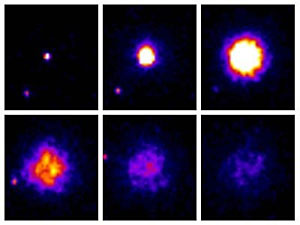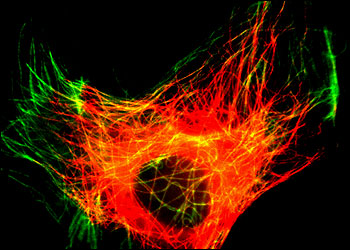
NIH Supports Microscopy
WALTHAM, Mass., and NEW HAVEN, Conn., Sept. 27, 2007 -- The National Institutes of Health (NIH) has awarded more than $5 million to two researchers working separately to advance the study of cancer, diabetes and neurological diseases by developing new microscopy techniques.
NIH Director Elias A. Zerhouni, MD, announced last week the major investment in the future of science with five-year grants totaling more than $105 million to 41 investigators who are considered "exceptionally innovative," and many of whom are in the early stages of their careers.
 “Novel ideas and new investigators are essential ingredients for scientific progress, and the creative scientists we recognize with NIH Director’s Pioneer Awards and NIH Director’s New Innovator Awards are well-positioned to make significant -- and potentially transformative -- discoveries in a variety of areas,” said Zerhouni. “The conceptual and technological breakthroughs that are likely to emerge from their highly innovative approaches to major research challenges could speed progress toward important medical advances.”
“Novel ideas and new investigators are essential ingredients for scientific progress, and the creative scientists we recognize with NIH Director’s Pioneer Awards and NIH Director’s New Innovator Awards are well-positioned to make significant -- and potentially transformative -- discoveries in a variety of areas,” said Zerhouni. “The conceptual and technological breakthroughs that are likely to emerge from their highly innovative approaches to major research challenges could speed progress toward important medical advances.”
This is the first group of New Innovator Awards and the fourth group of Pioneer Awards. Both programs are part of an NIH Roadmap for Medical Research initiative that tests new approaches to supporting research. The Pioneer Awards, five-year grants of $2.5 million to cover the researchers' direct costs, support scientists at any career stage, while New Innovator Awards, five-year, direct-cost grants of $1.5 million, are reserved for new investigators who have not received an NIH regular research (R01) or similar grant.
The recipients were selected by Zerhouni with the assistance of a group of outside experts and the NIH director's advisory committee. A pool of 450 applicants competed for the 12 Pioneer Awards, while 2100 vied for 29 New Innovator research grants.
“In addition to supporting outstanding research, these programs represent experiments in new ways of identifying and funding promising but unconventional ideas, especially those from new investigators,” Zerhouni said.
Brandeis neuroscientist and biology professor Gina Turrigiano will use the $2.5 million in direct cost funding from her Pioneer Award to develop a superresolution cryomicroscopy method for probing the structure of the synapse, which is one of the most complex molecular machines. This method will make it possible to determine how synapses are impaired by neurodevelopmental and neurological diseases.
“Potentially, this new technology will allow us to peer inside synaptic structures, see how these nanomachines are built, and understand how they malfunction in neurodegenerative diseases,” Turrigiano said.
Turrigiano received her PhD in neuroscience from the University of California, San Diego. She studies how experience rewires neural circuits within the brain's cortex, with a particular focus on synaptic changes that stabilize circuit activity. Turrigiano's honors include a Sloan Research Fellowship, a MacArthur Foundation Fellowship, and a McKnight Neuroscience of Brain Disorders Award.
Derek Toomre, assistant professor of cell biology at Yale School of Medicine and director of the Yale CINEMA (cinema imaging using new microscopy approaches) Laboratory, a light microscopy imaging center, will use his $2.5 million New Innovator Award, which includes $1 million for Yale's indirect costs, to develop optical techniques for a new generation of microscopes that will help in researching cancer and diabetes, among other diseases.

A high-resolution time-lapse view of a single vesicle (about 100 nanometers across) fusing with a cell surface, taken using TIRFM (total internal reflection fluorescent microscopy) imaging. (Image courtesy Derek Toomre)
The powerful new microscopes being created in Toomre’s lab will permit researchers to watch membrane trafficking and signaling in three dimensions with unprecedented resolution. His group will apply this technology to understand the trafficking pathways that regulate insulin-stimulated delivery of glucose transporters to the cell surface -- a process that is disrupted in type 2 diabetes.
Specifically, Toomre and his colleagues will use the new microscopes to analyze trafficking and signaling at the cell cortex -- a region that is a cell’s gateway to its environment and is abuzz with activity. It is where molecules are secreted, signaling complexes are assembled, cell-surface receptors are internalized, and the cell’s internal scaffolding is remodeled. Studies of the cell cortex are important for understanding secretion, cell migration, and signal transduction and downregulation—and how these processes go awry in diseases such as cancer and diabetes.
“Our ability to understand this important region is limited by our ability to see it in living cells,” Toomre said. He said one important challenge facing modern biology is to understand how individual biochemical reactions are integrated in space and time. Increasingly, new vital probes and optical methods have begun to provide unique insight into how molecules, vesicles, organelles and whole cells are reorganized in response to internal and external cues. Toomre said that “only by pushing new instrumental and quantitative methods in imaging can an important emerging challenge be met -- integrating complex information in dynamic cellular systems.”
Many of the cellular activities that his lab wishes to study cannot be easily seen through traditional microscopy. To tackle this problem, Toomre’s lab employs total internal reflection fluorescent microscopy (TIRFM), which is based on the same optical principles that are used to transmit information thousands of miles through fiber optic cables.

A light microscopy image of a cell containing GFP-labeled microtubules, as seen by both TIRFM (green) and epi-fluorescence (red). (Image courtesy Derek Toomre)
Using an optical sleight of hand, TIRFM imaging (also called evanescent wave microscopy) can illuminate a very thin section of the lower cortical region of the cell (as thin as 50 nanometers) and thus provide exquisitely high signal-to-background images -- so high that even single molecules can be visualized.
A new generation of variable-angle TIRFM microscopes proposed by Toomre’s team will prevent artifacts created by conventional microscopes that can obscure the image and will also allow the depth of the light beam’s penetration to be rapidly varied. Toomre’s innovative and holistic approach spans across instrumentation, cell biology, and quantitative biology.
Toomre received his BS from the University of Colorado at Boulder and his PhD at the University of California, San Diego. He did his postdoctoral research in Germany with Kai Simons, an internationally renowned cell biologist.
For more information, visit: www.brandeis.edu or www.yale.edu
Published: September 2007